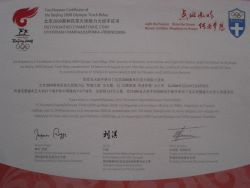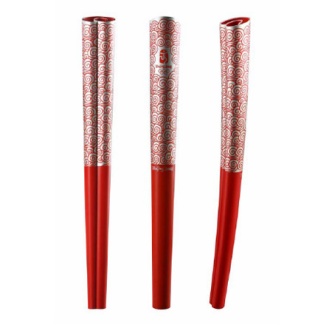Torch and Torch Relay
The Beijing Olympic Torch
has a very strong Chinese flavour. The design of the Torch owns much of its inspiration to the concept of "Lucky Cloud" which represents the thousand-year-old Chinese culture of harmony between man and nature. The paper scroll shape demonstrates one of the greatest inventions China had presented to the world. The application of "China red", a special shade of red which was first used on lacquerware in China`s Han Dynasty about 2000 years ago, distinguishes the Beijing Olympic torch from all the previous Games torches, with a contrast between red and silver
colours that produces a striking visual effect. |
| Description: | Curved form in the shape of a paper scroll, with lucky clouds graphic expressing harmony |
|---|---|
| Material: | Red and anodized aluminum |
| Fuel: | |
| Torch measure: | Lenght: 72 cm Weight: 980 gr |
| Torches total: | |
| Design by: | Designed by a team from Lenovo Group, public Company, Beijing China |
| Manufacturer: | |
| Date of the torch relay: | 24.03.2008 - 08.08.2008 |
| Duration: | 138 days |
| Numbers of runners: | about 21.880 |
| Distance total: | about 137.000 km |
| Name of the last runner: | former Chinese gymnast Li Ning |
The Beijing 2008 Olympic Torch Relay will traverse the longest distance, cover the greatest area and include the largest number of people, according to plans released tonight during a grand ceremony held in the China Millennium Monument in Beijing by BOCOG, the Beijing Organizing Committee for the Games of XXIX Olympiad. The planned route, revealed by Luo Gan, member of the standing committee of the Political Bureau of CPC Central Committee, and who was joined by International Olympic Committee President Jacques Rogge, would last 130 days and travel 137,000 kilometers. And the Beijing 2008 Olympic torch design was unveiled by State Councilor and BOCOG first vice-president Chen Zhili, with IOC Coordination Commission Chairman Hein Verbruggen alongside. Validated by IOC, the Olympic Flame will be lit in Olympia, Greece according to tradition on March 25, 2008. From March 25 - 30, the Torch Relay will travel across Greece, ending at the Panathinaiko Stadium, the site of the first modern Olympic Games in 1896. After the handover ceremony in the stadium, the Olympic Flame will arrive in Beijing on March 31, 2008. In Beijing, a ceremony will be held for the arrival of the flame into China and Beijing 2008 Olympic torch relay will commence. The torch is 72 centimetres high, weighs 985 grams
and is made of aluminium.
The torch is of a curved surface form, with etching and anodizing being
used during its production. A torch can usually keep burning for
approximately
15 minutes in conditions where the flame is 25 to 30 centimetres high
in
a windless environment. |

Torchbearer diploma



